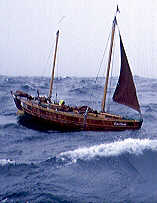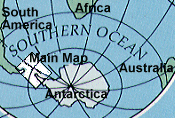
![]()
.
.
.
.
.
.
.
.
.
.
.
.
.
.

![]()

[
Logbook Index ]

Log
Entry for 27 January 1997
Position 1200 GMT: 56 50S 40 59W
Click
map for detailed position chart showing relative track of James Caird
and Pelagic as expedition continues to South Georgia.
Wind 5
knots from N-NE. Rain and misty. Temp 7°C.
First hand
accounts of the events on the Tom Crean and Pelagic prior to the
rescue.
|
Paddy Barry: Jamie Young: Frank Nugent: Mike Barry: Jarlath Cunnane: 24 hrs after abandoning ship the South Aris team is on Pelagic doing watches and cooking meals, perfectly reintegrated into another boat's crew. For them Shackleton's trip continues. The aim is to get to South Georgia and complete the mountain traverse in Shackleton's, Worsley's, and Crean's footsteps. A day after having been brought to safety, there is still no doubt about their decision. It was taken unanimously, after a meeting in which various options were considered. The option of asking Pelagic to tow the boat through the gales was discarded as unrealistic. The option of continuing on was dropped after being examined from all possible angles. The Tom Crean rolled over 3 times and always came back up but Bob Rice's professional weather forecast envisioned at least another week of similar if not worse conditions. Jamie tells me it was not so much the danger of going down he was thinking about during the discussions, but the risk of hypothermia or psychological collapse in the crew. The storm began building up early on 24th January. By 0800 it was a northerly Force 7 and by 1100 Tom Crean was hove-to. This tactic had been used a few days earlier and created no problem. But by evening, the wind was blowing constantly over 50kts and the swell was big and getting bigger. There was no let up during the night and between 0600 and 0700 the Tom Crean rolled over for the first time. "Come up, Come up, Come up, Baby!!" yelled Frank as he was being thrown upside down in the cabin. Jarlath was wedged into the entrance of the living quarters suffering a hard blow in his back ribs. "It was a great moment when she decided to come back" he said, and Frank went on to describe how everybody seemed to know exactly what to do as soon as the boat was upright. "The water was pumped out quickly and everything more or less put back into place, ready to take another hit," he says. The second time Jamie was out in the cockpit when the Crean went over. He held on with both hands and, according to Jarlath, he was already pumping before the boat was up. Jamie remarked "I've been in similar conditions before and you have to get on with it. When survival is at stake you are very focused. But the most surprising moment for me was when she went down the first time. I was lying in one of the side bunks that had a sort of plexiglass window on top of it. All of a sudden I found myself looking at the Tom Crean's mast underwater; upside down, looking at the mast totally immersed in greeny blue water!". Radio contact with the Pelagic was maintained throughout the night of 24 January, every hour we recorded the two boats positions and calculated the distance between them. The Irishmen asked repeatedely for Pelagic to come up closer to them but it was impossible for us to sail upwind in those conditions. Skip could not risk Pelagic and it was very distressing to have to continue saying "we must still wait" to every request for information about our next move. At 1600 on 25 January, after calculating both Pelagics and the Tom Crean's drift, Patrick suggested the Crean try to sail downwind towards us instead of waiting for us to go upwind. The crew responded that it was much better to keep the bow to the sea, riding to the sea anchor. They feared that sailing down wind would have meant rolling over again and preferred to wait. Bob Rice's detailed report predicted a lull in the weather by early morning on the 26 January. Skip decided to wait for the morning light although we reached the Crean in the evening of the 25th and passed very close to them. We had no choice but to heave-to again and try to keep within a few miles range. At 0300, the Pelagic crew was on deck, motoring towards the Crean and preparing the dinghy for the recovery. Skip told me he has never done a rescue operation of this type but that there was really not much doubt on what to do: the plan of action was obvious. He'll tell you personally about it in the next article! Elena Caputo |
